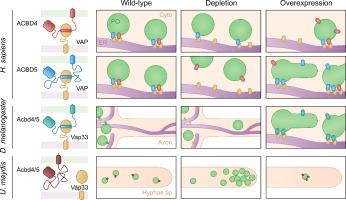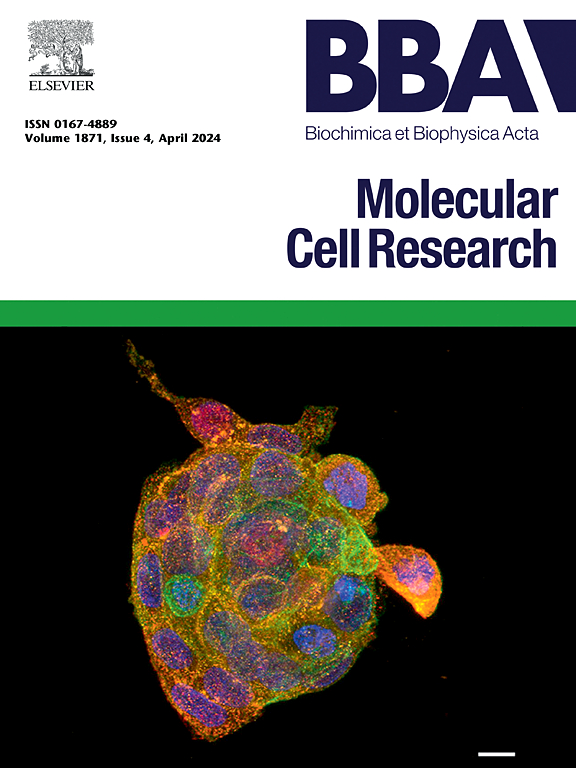New insights into the functions of ACBD4/5-like proteins using a combined phylogenetic and experimental approach across model organisms
IF 4.6
2区 生物学
Q1 BIOCHEMISTRY & MOLECULAR BIOLOGY
Biochimica et biophysica acta. Molecular cell research
Pub Date : 2024-09-11
DOI:10.1016/j.bbamcr.2024.119843
引用次数: 0
Abstract
Acyl-CoA binding domain-containing proteins (ACBDs) perform diverse but often uncharacterised functions linked to cellular lipid metabolism. Human ACBD4 and ACBD5 are closely related peroxisomal membrane proteins, involved in tethering of peroxisomes to the ER and capturing fatty acids for peroxisomal β-oxidation. ACBD5 deficiency causes neurological abnormalities including ataxia and white matter disease. Peroxisome-ER contacts depend on an ACBD4/5-FFAT motif, which interacts with ER-resident VAP proteins. As ACBD4/5-like proteins are present in most fungi and all animals, we combined phylogenetic analyses with experimental approaches to improve understanding of their evolution and functions. Notably, all vertebrates exhibit gene sequences for both ACBD4 and ACBD5, while invertebrates and fungi possess only a single ACBD4/5-like protein. Our analyses revealed alterations in domain structure and FFAT sequences, which help understanding functional diversification of ACBD4/5-like proteins. We show that the Drosophila melanogaster ACBD4/5-like protein possesses a functional FFAT motif to tether peroxisomes to the ER via Dm_Vap33. Depletion of Dm_Acbd4/5 caused peroxisome redistribution in wing neurons and reduced life expectancy. In contrast, the ACBD4/5-like protein of the filamentous fungus Ustilago maydis lacks a FFAT motif and does not interact with Um_Vap33. Loss of Um_Acbd4/5 resulted in an accumulation of peroxisomes and early endosomes at the hyphal tip. Moreover, lipid droplet numbers increased, and mitochondrial membrane potential declined, implying altered lipid homeostasis. Our findings reveal differences between tethering and metabolic functions of ACBD4/5-like proteins across evolution, improving our understanding of ACBD4/5 function in health and disease. The need for a unifying nomenclature for ACBD proteins is discussed.

通过跨模式生物的系统发育和实验相结合的方法,对 ACBD4/5 类蛋白的功能有了新的认识。
含酰基-CoA 结合域的蛋白(ACBDs)具有与细胞脂质代谢相关的多种功能,但这些功能往往没有得到表征。人类 ACBD4 和 ACBD5 是密切相关的过氧化物酶体膜蛋白,参与将过氧化物酶体拴系到 ER 上,并捕获脂肪酸用于过氧化物酶体 β 氧化。缺乏 ACBD5 会导致神经系统异常,包括共济失调和白质疾病。过氧化物酶体与 ER 的接触依赖于 ACBD4/5-FFAT 基序,该基序与驻留在 ER 的 VAP 蛋白相互作用。由于 ACBD4/5 类似蛋白存在于大多数真菌和所有动物中,我们将系统发育分析与实验方法相结合,以加深对其进化和功能的了解。值得注意的是,所有脊椎动物都有 ACBD4 和 ACBD5 的基因序列,而无脊椎动物和真菌只有单一的 ACBD4/5 样蛋白。我们的分析揭示了结构域结构和 FFAT 序列的变化,这有助于理解 ACBD4/5 样蛋白的功能多样性。我们发现黑腹果蝇 ACBD4/5 样蛋白具有一个功能性 FFAT 基序,可通过 Dm_Vap33 将过氧物酶体拴系到 ER 上。Dm_Acbd4/5的缺失会导致翅神经元中的过氧物酶体重新分布,并降低预期寿命。与此相反,丝状真菌 Ustilago maydis 的 ACBD4/5 样蛋白缺乏 FFAT 基序,不能与 Um_Vap33 相互作用。缺失 Um_Acbd4/5 会导致过氧异构体和早期内体在顶端积累。此外,脂滴数量增加,线粒体膜电位下降,这意味着脂质平衡发生了改变。我们的发现揭示了ACBD4/5样蛋白的系链和代谢功能在进化过程中的差异,提高了我们对ACBD4/5在健康和疾病中的功能的认识。我们还讨论了为 ACBD 蛋白统一命名的必要性。
本文章由计算机程序翻译,如有差异,请以英文原文为准。
求助全文
约1分钟内获得全文
求助全文
来源期刊
CiteScore
10.00
自引率
2.00%
发文量
151
审稿时长
44 days
期刊介绍:
BBA Molecular Cell Research focuses on understanding the mechanisms of cellular processes at the molecular level. These include aspects of cellular signaling, signal transduction, cell cycle, apoptosis, intracellular trafficking, secretory and endocytic pathways, biogenesis of cell organelles, cytoskeletal structures, cellular interactions, cell/tissue differentiation and cellular enzymology. Also included are studies at the interface between Cell Biology and Biophysics which apply for example novel imaging methods for characterizing cellular processes.

 求助内容:
求助内容: 应助结果提醒方式:
应助结果提醒方式:


